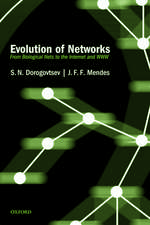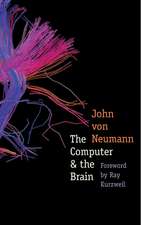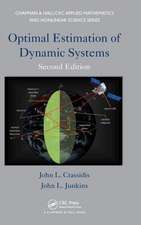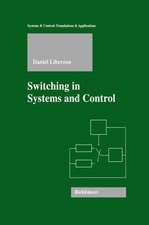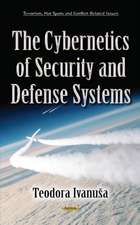H-infinity Engineering and Amplifier Optimization: Systems & Control: Foundations & Applications
Autor Jefferey C. Allenen Limba Engleză Hardback – 13 iul 2004
The amplification of a weak, noisy, wideband signal is a canonical problem in electrical engineering. Given an amplifier, matching circuits must be designed to maximize gain, minimize noise, and guarantee stability. These competing design objectives constitute a multiobjective optimization problem. Because the matching circuits are H-infinity functions, amplifier design is really a problem in H-infinity multiobjective optimization.
| Toate formatele și edițiile | Preț | Express |
|---|---|---|
| Paperback (1) | 640.06 lei 6-8 săpt. | |
| Birkhäuser Boston – 10 noi 2012 | 640.06 lei 6-8 săpt. | |
| Hardback (1) | 646.11 lei 6-8 săpt. | |
| Birkhäuser Boston – 13 iul 2004 | 646.11 lei 6-8 săpt. |
Din seria Systems & Control: Foundations & Applications
- 18%
 Preț: 1050.35 lei
Preț: 1050.35 lei - 17%
 Preț: 490.57 lei
Preț: 490.57 lei - 15%
 Preț: 654.95 lei
Preț: 654.95 lei - 15%
 Preț: 654.43 lei
Preț: 654.43 lei - 15%
 Preț: 641.85 lei
Preț: 641.85 lei -
 Preț: 404.51 lei
Preț: 404.51 lei -
 Preț: 400.10 lei
Preț: 400.10 lei -
 Preț: 394.51 lei
Preț: 394.51 lei - 15%
 Preț: 640.37 lei
Preț: 640.37 lei - 15%
 Preț: 635.80 lei
Preț: 635.80 lei - 18%
 Preț: 790.28 lei
Preț: 790.28 lei -
 Preț: 382.36 lei
Preț: 382.36 lei -
 Preț: 386.39 lei
Preț: 386.39 lei - 18%
 Preț: 946.24 lei
Preț: 946.24 lei - 18%
 Preț: 1395.94 lei
Preț: 1395.94 lei - 18%
 Preț: 961.10 lei
Preț: 961.10 lei - 18%
 Preț: 968.19 lei
Preț: 968.19 lei -
 Preț: 388.34 lei
Preț: 388.34 lei - 15%
 Preț: 645.47 lei
Preț: 645.47 lei -
 Preț: 404.13 lei
Preț: 404.13 lei - 18%
 Preț: 965.02 lei
Preț: 965.02 lei - 15%
 Preț: 649.87 lei
Preț: 649.87 lei - 18%
 Preț: 974.98 lei
Preț: 974.98 lei -
 Preț: 386.00 lei
Preț: 386.00 lei -
 Preț: 393.52 lei
Preț: 393.52 lei - 15%
 Preț: 642.68 lei
Preț: 642.68 lei -
 Preț: 390.84 lei
Preț: 390.84 lei -
 Preț: 388.72 lei
Preț: 388.72 lei - 15%
 Preț: 655.45 lei
Preț: 655.45 lei - 20%
 Preț: 1003.63 lei
Preț: 1003.63 lei - 15%
 Preț: 648.89 lei
Preț: 648.89 lei - 15%
 Preț: 645.47 lei
Preț: 645.47 lei -
 Preț: 386.00 lei
Preț: 386.00 lei - 18%
 Preț: 952.89 lei
Preț: 952.89 lei -
 Preț: 396.40 lei
Preț: 396.40 lei - 15%
 Preț: 642.68 lei
Preț: 642.68 lei - 15%
 Preț: 650.19 lei
Preț: 650.19 lei
Preț: 646.11 lei
Preț vechi: 760.13 lei
-15% Nou
Puncte Express: 969
Preț estimativ în valută:
123.64€ • 132.21$ • 103.08£
123.64€ • 132.21$ • 103.08£
Carte tipărită la comandă
Livrare economică 18 aprilie-02 mai
Preluare comenzi: 021 569.72.76
Specificații
ISBN-13: 9780817637804
ISBN-10: 081763780X
Pagini: 249
Ilustrații: XXXIII, 249 p.
Greutate: 0.58 kg
Ediția:2004
Editura: Birkhäuser Boston
Colecția Birkhäuser
Seria Systems & Control: Foundations & Applications
Locul publicării:Boston, MA, United States
ISBN-10: 081763780X
Pagini: 249
Ilustrații: XXXIII, 249 p.
Greutate: 0.58 kg
Ediția:2004
Editura: Birkhäuser Boston
Colecția Birkhäuser
Seria Systems & Control: Foundations & Applications
Locul publicării:Boston, MA, United States
Public țintă
ResearchCuprins
1 Electric Circuits for Mathematicians.- 2 The Amplifier Matching Problem.- 3 H? Tools for Electrical Engineers.- 4 Lossless N-Ports.- 5 The H? Framework.- 6 Amplifier Matching Examples.- 7 H? Multidisk Methods.- 8 State-Space Methods for Single Amplifiers.- 9 State-Space Methods for Multiple Amplifiers.- 10 Research Topics.- A The Axioms of Electric Circuits.- A.1 Krein Spaces and Angle Operators.- A.2 N-Ports ?Angle Operators.- A.3 Time Invariance ?Convolution.- A.4 Causality ? Analyticity.- Existence.- B Taylor’s Expansion and the Descent Lemma.- Taylor’s Expansion.- The Kolmogorov Criterion.- 237.- 245.
Recenzii
"This book deals with the electronic amplifier matching problem and proposes a general approach in the H-infinity framework. Loosely speaking, the design procedure is a multi-objective optimization which simultaneously maximizes the transducer power gain, minimizes the noise figure, and guarantees stability. Basically these objectives are competing, and the book shows how the H-infinity framework provides tools to circumvent this problem…. The book begins with a thorough background on circuit theory, H-infinity and control theory, and then deals with the amplifier matching problem, of which some examples are displayed…. The monograph concludes with a collection of open problems." —Mathematical Reviews
Textul de pe ultima copertă
H-infinity engineering continues to establish itself as a discipline of applied mathematics. As such, this extensively illustrated monograph makes a significant application of H-infinity theory to electronic amplifier design, demonstrating how recent developments in H-infinity engineering equip amplifier designers with new tools and avenues for research.
The amplification of a weak, noisy, wideband signal is a canonical problem in electrical engineering. Given an amplifier, matching circuits must be designed to maximize gain, minimize noise, and guarantee stability. These competing design objectives constitute a multiobjective optimization problem. Because the matching circuits are H-infinity functions, amplifier design is really a problem in H-infinity multiobjective optimization.
To foster this blend of mathematics and engineering, the author begins with a careful review of required circuit theory for the applied mathematician. Similarly, a review of necessary H-infinity theory is provided for the electrical engineer having some background in control theory. The presentation emphasizes how to (1) compute the best possible performance available from any matching circuits; (2) benchmark existing matching solutions; and (3) generalize results to multiple amplifiers.
As the monograph develops, many research directions are pointed out for both disciplines. The physical meaning of a mathematical problem is made explicit for the mathematician, while circuit problems are presented in the H-infinity framework for the engineer. A final chapter organizes these research topics into a collection of open problems ranging from electrical engineering, numerical implementations, and generalizations to H-infinity theory.
The amplification of a weak, noisy, wideband signal is a canonical problem in electrical engineering. Given an amplifier, matching circuits must be designed to maximize gain, minimize noise, and guarantee stability. These competing design objectives constitute a multiobjective optimization problem. Because the matching circuits are H-infinity functions, amplifier design is really a problem in H-infinity multiobjective optimization.
To foster this blend of mathematics and engineering, the author begins with a careful review of required circuit theory for the applied mathematician. Similarly, a review of necessary H-infinity theory is provided for the electrical engineer having some background in control theory. The presentation emphasizes how to (1) compute the best possible performance available from any matching circuits; (2) benchmark existing matching solutions; and (3) generalize results to multiple amplifiers.
As the monograph develops, many research directions are pointed out for both disciplines. The physical meaning of a mathematical problem is made explicit for the mathematician, while circuit problems are presented in the H-infinity framework for the engineer. A final chapter organizes these research topics into a collection of open problems ranging from electrical engineering, numerical implementations, and generalizations to H-infinity theory.
Caracteristici
Book appeals to a cross audience of applied mathematicians and engineers Applies H-infinity theory to electronic amplifier design Demonstrates how recent developments in H-infinity engineering equip amplifier designers with new tools and avenues for research Research topics are organized into a collection of open problems



